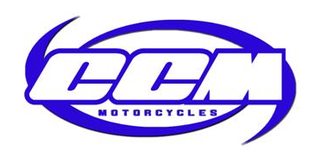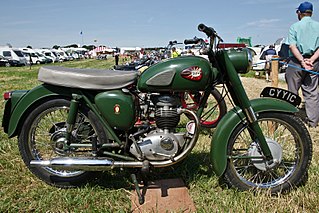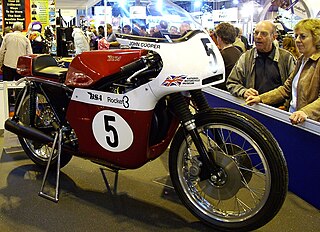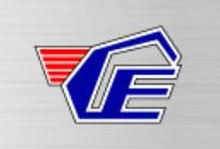
Eric Cheney was an English motorcycle racer, designer and independent constructor. He was known as one of the best motorcycle frame designers of his era, concentrating mainly in the off-road competition aftermarket.

Motocross is a form of off-road motorcycle racing held on enclosed off-road circuits. The sport evolved from motorcycle trials competitions held in the United Kingdom.

The Tribsa, or Tri-B.S.A., was a custom built café racer or off road motorcycle of the 1960s and 1970s. Its name was an amalgamation of Triumph and BSA. The purpose was to combine the best elements of each marque to give a superior bike to either.

Česká zbrojovka is a Czech company producing forklifts Desta and components for the automobile industry, it is former firearms manufacturer, also known for making ČZ motorcycles. ČZ was established as a branch of the Škoda Works Armament in Strakonice, Czechoslovakia in September 1919.

Unit construction is the design of larger motorcycles where the engine and gearbox components share a single casing. This sometimes includes the design of automobile engines and was often loosely applied to motorcycles with rather different internal layouts such as the flat twin BMW models.

Associated Motor Cycles (AMC) was a British motorcycle manufacturer founded by the Collier brothers as a parent company for the Matchless and AJS motorcycle companies. It later absorbed Francis-Barnett, James, and Norton before incorporation into Norton-Villiers. Henry Herbert Collier founded Matchless as a cycle company in 1878. His sons Henry (Harry) and Charles (Charlie) joined him and the name was changed to H. Collier & Sons.

The BSA Gold Star is a motorcycle made by BSA from 1938 to 1963. They were 350 cc and 500 cc single-cylinder four-stroke production motorcycles known for being among the fastest bikes of the 1950s. Being hand built and with many optional performance modifications available, each motorcycle came from the factory with documented dynamometer test results, allowing the new owner to see the horsepower (bhp) produced.

Clews Competition Machines (CCM) is a British motorcycle manufacturer based in Bolton, England. CCM was founded in 1971 by Alan Clews and gained notability for producing specialised BSA powered motocross machines. The company has produced a variety of motorcycle models over its history using a variety engine suppliers including; Rotax, Suzuki and Kymco.
Norton Villiers Triumph (NVT) was a British motorcycle manufacturer, formed by the British government to continue the UK motorcycling industry, until the company's ultimate demise.
Greeves Motorcycles was a British motorcycle manufacturer founded by Bert Greeves which produced a range of road machines, and later competition mounts for observed trials, scrambles and road racing. The original company produced motorcycles from 1952, funded by a contract with the Ministry of Pensions for their Invacar, a three-wheeler for disabled drivers.

The featherbed frame was a motorcycle frame invented by the McCandless brothers and offered to the British Norton motorcycle company to improve the performance of their racing motorcycles in 1950. It was considered revolutionary at the time, and the best handling frame that a racer could have. Later adopted for Norton production motorcycles, it was also widely used by builders of custom hybrids such as the Triton, becoming legendary and remaining influential to this day.

The BSA C15 was a 250 cc single-cylinder ohv motorcycle manufactured by the British company BSA from September 1958 until 1967, and was BSA's first four-stroke unit-construction bike. For most of that period, after the introduction of 'Learner Laws' in 1961, a 250 cc was the largest capacity solo machine that a learner could ride unaccompanied when displaying L-plates in the United Kingdom. A road-going Sports derivative was added in 1961, and off-road versions, for Trials and Scrambles, were also available in the range.

John Banks is a British former professional motocross racer. He competed in the Motocross World Championships from 1963 to 1977. A four-time 500cc British national champion, Banks was twice runner-up in the 500cc motocross world championship.
The BSA B50 was a single-cylinder 499 cc (30.5 cu in) ohv motorcycle, produced by BSA at their factory in Small Heath, Birmingham. The last of the big capacity unit-construction singles from the Birmingham Small Arms company, it had an alloy engine with a bore of 84 mm (3.3 in) and a stroke of 90 mm (3.5 in). As well as the road version, special models were produced for off-road competition use.

BSA motorcycles were made by the Birmingham Small Arms Company Limited (BSA), which was a major British industrial combine, a group of businesses manufacturing military and sporting firearms; bicycles; motorcycles; cars; buses and bodies; steel; iron castings; hand, power, and machine tools; coal cleaning and handling plants; sintered metals; and hard chrome process.

The BSA B25 was a series of 250 cc (15 cu in) unit construction single-cylinder OHV four-stroke motorcycles made by the Birmingham Small Arms Company. Developed from the BSA C15, the machines were produced between 1967 and 1971. The B25 was the fastest British production 250.

The BSA B40 was a series of 350 cc (21 cu in) unit construction single-cylinder OHV four-stroke motorcycles made by the Birmingham Small Arms Company. Developed from the BSA C15, the machines were produced between 1961 and 1967 for civilian use. Military versions were manufactured from 1967 to 1970. Around 14,000 machines were built in total.

The BSA B44 was a series of 441 cc (26.9 cu in) unit construction single-cylinder OHV four-stroke motorcycles made by the Birmingham Small Arms Company between 1966 and 1970. The machines were developed from the BSA World Championship Motocross machines, which were themselves based on the C15/B40.

The BSA/Triumph racing triples were three cylinder 750 cc racing motorcycles manufactured by BSA/Triumph and raced with factory support from 1969-1974. There were road racing, production racing, endurance racing and flat track variants. The machines were based on the road-going BSA Rocket 3/Triumph Trident.

The Ducati 450 R/T (road/trail) is a 436 cc (26.6 cu in) single cylinder bevel drive desmodromic SOHC motorcycle produced by the Italian manufacturer Ducati from 1971 to 1974. Initially produced at the request of the American importers Berliner Motor Corporation as a pure motocross machine exclusively for the American Market, only a few hundred machines were made of this type. It is the only motocross bike to use desmodromic valves. An optional street equipment kit was available. From 1972 it was produced for the European Market as a street legal on/off road machine, which was sometimes known as the 450 T/S.

















